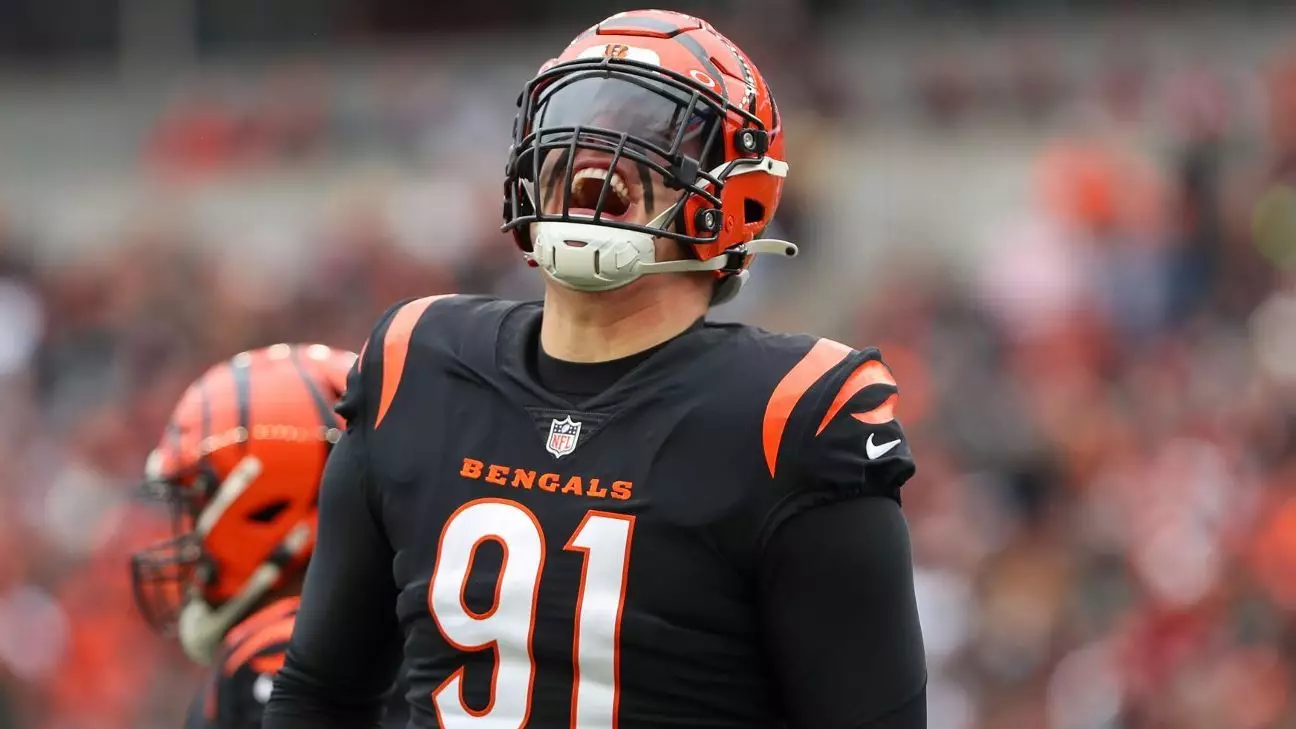Cincinnati Bengals defensive end Trey Hendrickson’s recent revelation regarding stalled contract negotiations brings to light not just the complexities of player management in professional sports, but also the emotional weight athletes carry as they navigate financial commitments. Hendrickson’s announcement, made through ESPN’s Adam Schefter, reflects a simmering frustration with a franchise that has, ironically, benefited from his exceptional performance on the field. With no ongoing communication between Hendrickson’s representatives and the organization, questions arise about how this fractured relationship may affect both the player and the team going forward.
The 30-year-old defensive star finds himself at a crossroads as he enters the final year of his contract. Last season, Hendrickson was a standout performer in the league, leading in sacks with an impressive 17.5 and earning All-Pro honors—an accolade that places him among the elite talents in football. Given these accomplishments, the expectation for a financially rewarding agreement is not only anticipated but almost a given. However, it seems the Bengals have issued offers that fell short of what Hendrickson feels he deserves based on previous conversations about his future with the team.
The Frustration of Miscommunication
Hendrickson’s remarks highlight a breakdown in communication that serves as a significant barrier to resolution. The defensive end’s expression of disappointment is palpable when he states that the organization’s offers “did not reflect the vision we shared.” This statement illustrates a fundamental disconnect that goes beyond mere dollar signs; it suggests deeper issues at play regarding mutual respect and understanding between the player and management. His assertion that contract discussions have reached a standstill is an unsettling prospect for Bengals fans, given Hendrickson’s integral role in the team’s defensive unit.
The implications are clear: when a team and player are not aligned in their goals, it paves the way for misunderstandings and unmet expectations. Hendrickson articulated that it “has been hard to do when there is no discussion and an evident lack of interest in reaching mutual goals.” This sentiment resonates with the broader issues athletes face when dealing with franchise dynamics, especially when they believe their contributions warrant consideration and reward.
A Parallel Comparison: The Ja’Marr Chase Contract
Perhaps even more striking is the comparison between Hendrickson’s plight and that of fellow Bengal Ja’Marr Chase, whose recent $161 million contract solidified his status as the highest-paid non-quarterback. While Chase’s accomplishment should be celebrated, it also serves as a critical backdrop to Hendrickson’s frustrations. The disparity in contract negotiations amidst significant on-field success raises questions about the priorities of the Bengals’ front office. How can the franchise justify the treatment of a player who has consistently performed at an elite level while simultaneously rewarding other players with monumental contracts?
The situation is compounded by Hendrickson’s past experience when he initially requested a trade amidst a lack of commitment from the Bengals before being persuaded to attend voluntary workouts. His evident frustration with Bengals executive Katie Blackburn’s comments during the NFL’s annual league meeting further crystallizes the issues at hand. Blackburn’s suggestion that Hendrickson should find contentment at certain pay scales not only diminishes his contributions but also underscores a performative attitude toward athlete management that feels dismissive.
The Urgency for Resolution
As the Bengals gear up for organized team activities, the urgency for resolving Hendrickson’s contract woes becomes increasingly apparent. The upcoming season hinges on the ability of the team to ensure that their star players feel valued and respected. Hendrickson openly stated that he is not looking to be the highest-paid player in his position but expresses the need for the organization to engage in meaningful dialogue and reach a satisfactory agreement.
Moreover, Hendrickson’s contract issues are not an isolated instance; the situation is indicative of a larger trend in the NFL, where athletes frequently find themselves negotiating under pressure and must balance personal aspirations alongside team dynamics. As signs of dissent begin to mar Cincinnati’s locker room atmosphere, it begs the question: How long before the tension reaches a tipping point? Keeping such key players happy is not merely about financials; it’s about cultivating an environment where collaboration and open communication are priorities. The Bengals need to act swiftly to mend this rift before it evolves into a full-blown crisis that could unsettle their championship aspirations as they head into the new season.

